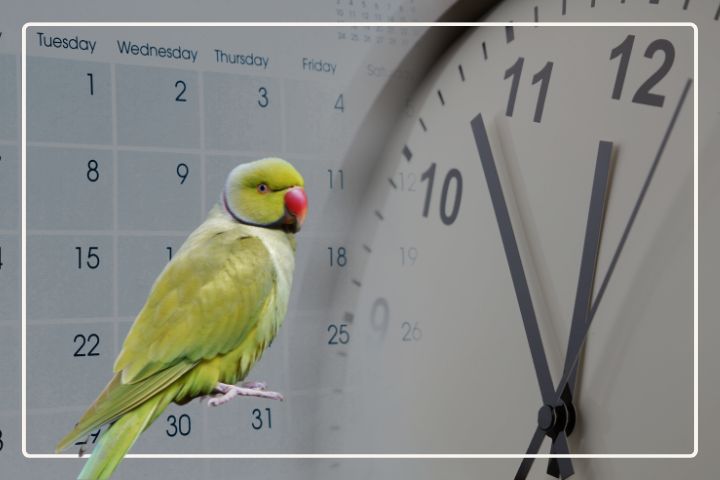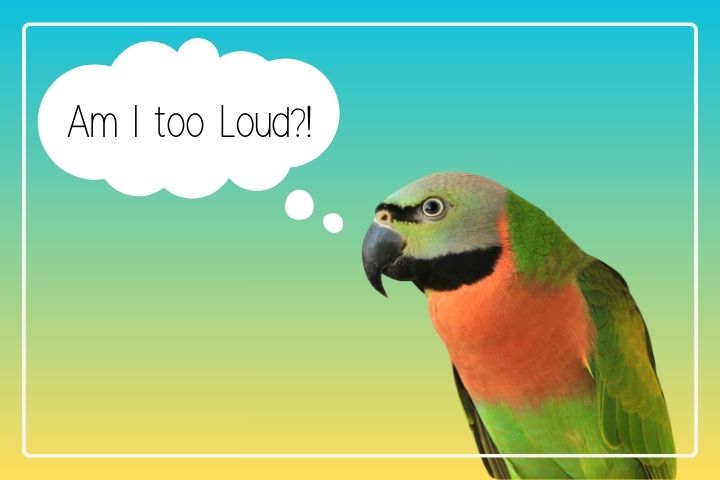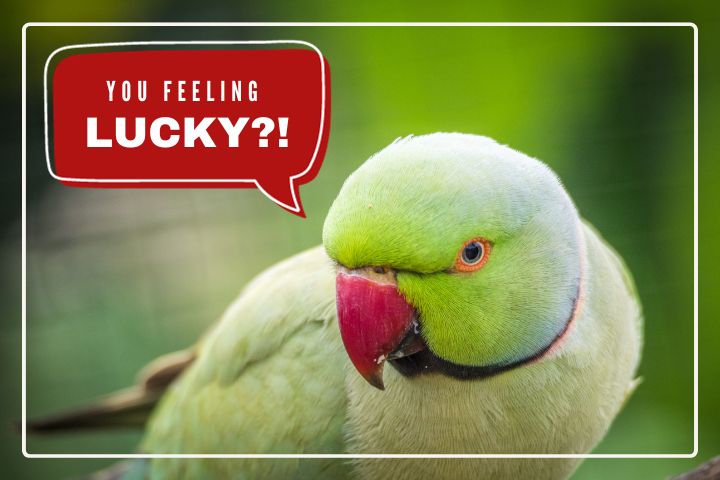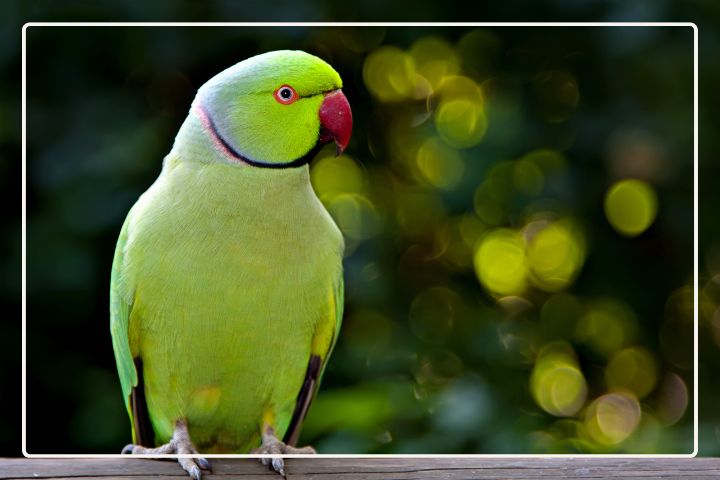What Age Do Alexandrine Parrots Molt?
As pet owners know well, parrots periodically shed their feathers in a process called molting. Though molting is natural, it can be an uncomfortable time for our feathered friends. So when do Alexandrine Parakeets experience their first molt? Let’s take a closer look at the molting timeline of these majestic birds.
Molting is the process where parrots shed their old, worn feathers and begin growing in new plumage. This is necessary since feathers continuously degrade from exposure to sun, dirt and other elements. Molting allows parrots to replace damaged feathers with fresh ones better suited for flying, insulation and attracting mates. Typically, parrots molt once or twice per year. The molt usually occurs after breeding season ends.
When Do Juvenile Alexandrine Parakeets Molt in the Wild?
In the wild, Alexandrine Parakeets breed between November and April. The female lays 2-4 eggs which hatch after 23-26 days. Once the chicks fledge at 8-10 weeks old, the juveniles will remain with the parents for up to two months to continue developing critical life skills.

It is during the period after breeding season ends that the young parakeets will begin their first molt. This typically occurs between June and August when the birds are 4-6 months old. The first molt helps the juveniles transition from their initial soft, downy body feathers to the sturdier feathers required for adulthood.
Some young Alexandrine Parakeets may take 2-3 molting periods over successive years to acquire their full adult plumage. The time frame also varies a bit between males and females.
Read our article What Do Alexandrine Parrots Eat?
Typical Age for First Molt in Captive Alexandrine Parakeets
For pet Alexandrine Parakeets kept indoors on a natural daylight schedule, the first molt typically mirrors that of wild parakeets, occurring between 4-6 months old. However, parakeets reliant on artificial lighting may molt later, around 6-10 months of age. Factors like diet, environment and stress levels can also delay the first molt.

Here are some considerations regarding molting age for captive Alexandrine Parakeets:
- Parakeets getting ample natural light through windows tend to molt on the early side, starting around 4-5 months old.
- Parakeets under artificial lighting may molt weeks or months later than wild counterparts. Lack of UV light can delay feather replacement.
- Ensuring your parakeet’s diet is rich in amino acids, proteins, vitamins A, E and minerals encourages timely molting.
- Molting may occur later in parakeets housed in stressful, noisy or crowded environments. Reduce stressors to support molting.
- Certain medical conditions like malnutrition, obesity or liver disease can impede molting at the anticipated age. Have your vet exam parakeets over 10 months old showing no signs of shedding juvenile feathers.
While the exact timing varies, most healthy, well-cared for captive Alexandrine Parakeets will have their first molt between 6-10 months old. Stay attentive to your bird’s needs so you can respond appropriately when those baby feathers start dropping!
Signs of a Juvenile’s First Molt
How can you tell if your young Alexandrine Parakeet is experiencing its first molt? Here are the key signs and symptoms to watch for:
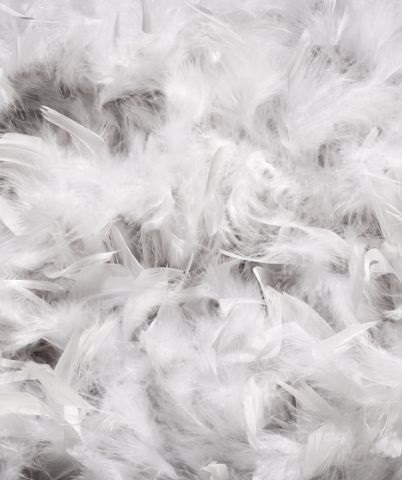
- Gradual Loss of Downy Feathers: One of the first indications of a first molt is downy, fluffy body feathers being shed as pin feathers emerge. This is especially noticeable on the head, neck and chest areas. You may see small bare patches as the soft juvenal plumage disappears.
- Increased Preening and Scratching: Your parakeet will likely spend more time preening (using its beak to groom feathers) and scratching its head and neck. This behavior helps remove old feather sheaths and relieve itchy skin as new feathers grow in.
- Irritable Mood: Your normally perky, energetic parakeet may seem more irritable and desire quiet time alone. Similar to teething babies, the discomfort of molting can put parakeets in an ill temper. Be patient with your moody bird during this time.
- Ruffled, Disheveled Appearance: During a molt, your parakeet may look scruffy, with feathers sticking out at odd angles. New pin feathers popping through the skin give a spiky, ruffled look. This is temporary until the feathers fully emerge.
- Increased Napping: Molting takes a lot of energy, so don’t be surprised if your parakeet sleeps more than usual. The extra rest enables growing strong, healthy new feathers. Make sure your bird gets 10-12 hours of quiet, uninterrupted sleep daily.
- Possible Appetite Decline: Some parakeets eat less while molting due to feeling under the weather. Offer fresh, enticing foods like sweet fruit, leafy greens, sprouts and eggs to encourage eating.
Be patient and provide some extra TLC as your parakeet navigates its first molt. Keep the room comfortably warm, offer baths and misting to relieve itching, and provide high protein foods to support feather growth. Limit handling the parakeet and let it rest as needed. The first molt can be uncomfortable, but your Alexandrine will soon be sporting a beautiful new coat of feathers.
Caring for a Molting Alexandrine Parakeet
The first molt can be an uncomfortable time for your Alexandrine Parakeet. Here are some tips on caring for your bird during this sensitive period:
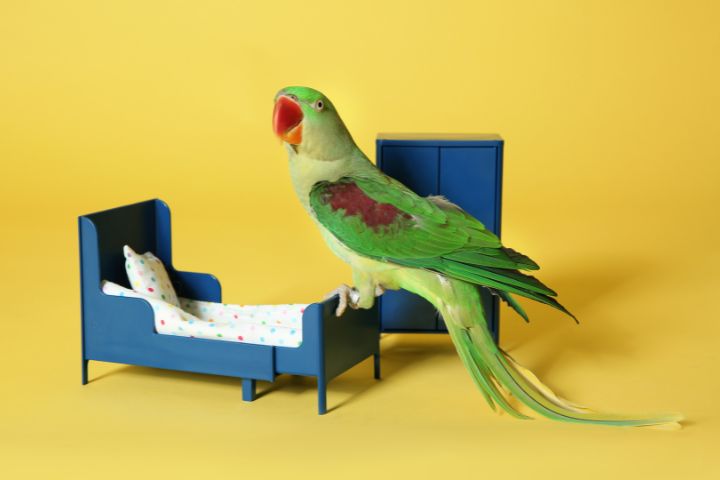
- Let your parakeet rest and nap undisturbed in a quiet space – Molting is exhausting work. Make sure your bird gets 10-12 hours of darkness and sleep per night. Cover the cage so it’s fully dark and minimize noise and distractions.
- Ensure your parakeet’s diet is rich in proteins, amino acids, vitamins and minerals – Feather growth requires nutrients like methionine, cystine, lysine, calcium, phosphorus, magnesium, and manganese. Feed high quality pellets, sprouted seeds, egg food, veggies and fruit.
- Offer baths or misting 2-3 times per week to relieve itchy and irritated skin – Bathing helps remove the waxy sheath around emerging pin feathers. Use a mister to provide a light spray of room temperature water.
- Avoid petting or handling your parakeet excessively – Your Alexandrine’s skin is sensitive during the molt. Limit contact to reduce discomfort.
- Watch for signs of damaging feather plucking versus normal molting – Plucking indicates a behavioral issue. If molting feathers look broken or stripped, talk to your vet.
- Keep plenty of chew and preening toys available – This deters over-preening of new feathers. Choose textured toys made from vegetable tanned leather, yucca or palm leaves.
- Talk to your avian vet if you have any concerns over your parakeet’s health – Unusual lethargy, appetite changes or other symptoms may need medical attention. Don’t delay contacting your vet.
With attentive care tailored to your parakeet’s needs, you can help it pass through the first molt without a hitch!
When Does the Adult Plumage Develop?
Alexandrine Parakeets require several molting periods before attaining their stunning adult plumage, which also differs slightly between males and females:

- Females acquire adult feathers after 2-3 molts by approximately 2 years old. Their neck ring remains greyish rather than solid black.
- Males take longer to fully mature – generally 2-4 molts over 3+ years. The male’s dramatic black neck ring and bright pink nape band appear last.
- Until about 3 years old, sexing juvenile and subadult parakeets is very difficult. Immature males resemble adult females. Only DNA testing or surgical sexing provides certainty before full adult traits emerge.
- All young Alexandrine Parakeets fledge with a maroon wing patch. But the nape band and neck ring develop incrementally across successive molts.
- The order and exact timing of molts varies individually. But most young parakeets will have recognizable adult plumage by their third year.
Be patient – it takes time for your Alexandrine Parakeet to grow from a fluffy, squeaking chick into a stunning adult specimen displaying regal plumage. With good nutrition and care, your beloved bird will get there before you know it!
How Often Do Alexandrine Parakeets Molt?
The molting frequency of Alexandrine Parakeets depends on whether the birds live in the wild or in captivity. For wild Alexandrines in their native Indian and Pakistani woodlands, the molting period is intimately connected to the tropical monsoon climate.
Molting Frequency in Wild Alexandrine Parakeets
- In the wild, Alexandrines generally molt 1-2 times per year following their breeding seasons which peak in winter and spring.
- The most significant molt occurs just after the main breeding season ends, during the hot and humid monsoon period from June to September. This large annual molt renews the parakeets’ feathers after the rigors of mating and nesting.
- Some wild Alexandrines may undergo a second, smaller molt in late fall around November as temperatures cool off. This further helps ensure prime feather condition headed into the winter breeding season.
- The precise timing and duration of these annual molts depends on factors like weather, food availability and the individual parakeet’s health. But wild Alexandrines are finely attuned to using environmental cues to guide their molt cycle.
Typical Molt Frequency for Captive Alexandrines
Similar to their wild counterparts, most captive Alexandrine Parakeets will molt 1-2 times per year. However, disruption of their photoperiod, diet or environment can lead to irregular or excessive molting.
What Influences Molting Frequency in Captive Birds?
For pet Alexandrine Parakeets, predicting molt cycles can be more challenging. Several key factors influence their molting frequency:
- Disrupted Day/Night Cycles – Lack of exposure to natural daylight can confuse a parakeet’s hormonal signals for molting periods. Abnormal photoperiods from indoor lighting lead to irregular molt schedules.
- Inadequate UV Light – Full spectrum lighting provides crucial UVA/UVB rays that stimulate healthy molt cycles. Without these wavelengths, molting may be impaired or delayed.
- Stress – Excessive noise, restricted space, lack of enrichment or abuse can induce stress that disrupts normal feather replacement.
- Medical Issues – Conditions like fatty liver disease, Psittacine Beak and Feather Disease or malnutrition can prevent healthy molt cycles.
- Excessive Bathing – Some experts posit that over-bathing may strip protective oils and trigger more frequent molts in certain birds. This is not fully substantiated but still bears consideration.
New owners should monitor their parakeet’s molt cycles annually and confer with an avian vet if concerned. With attentive husbandry, you can help maintain a healthy, predictable molt rhythm.
Read our article about Are Alexandrine Parrots Aggressive?
Conclusion
From fluffy hatchlings to regal adults, Alexandrine Parakeets undergo fascinating feathering transformations. Through a series of molts over their first few years, their juvenile plumage is replaced by the brilliant feathers which give the species its exotic beauty.
While the exact timing differs between individuals based on factors like lighting, diet and health, most Alexandrine Parakeets have their first molt around 4-10 months of age. This marks the transition from downy body feathers to more mature flight and contour feathers.
Once annual adult molt cycles commence around 2-3 years old, Alexandrine Parakeets generally molt once or twice per year. Though the molting process can be uncomfortable, with attentive, supportive care from their owners, these parakeets can sail through their molts and continue growing lovely new feathers year after year.


